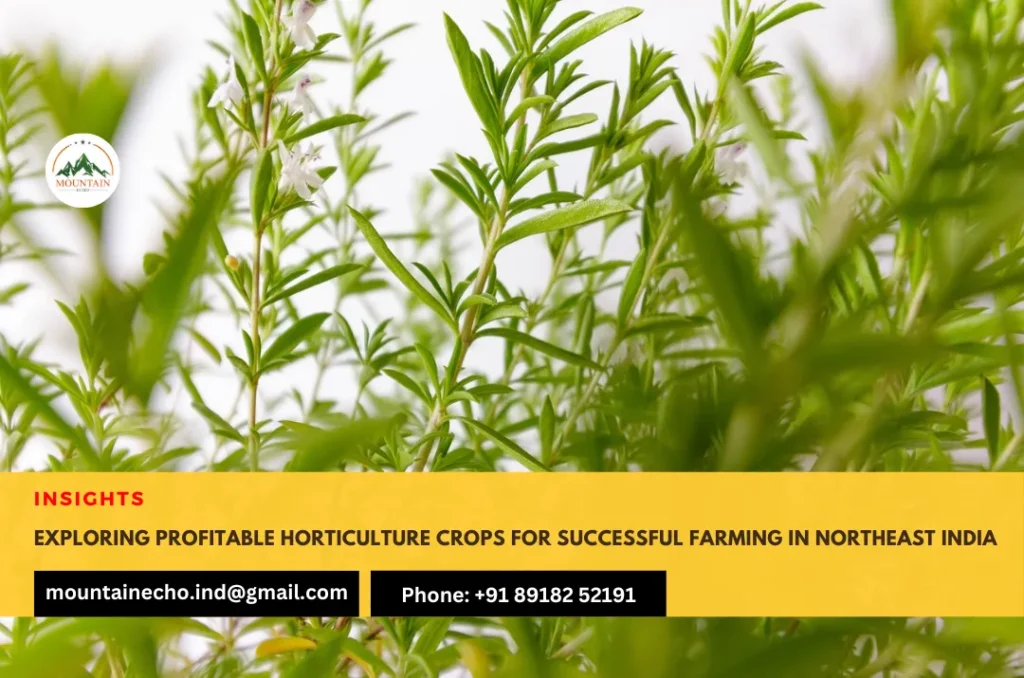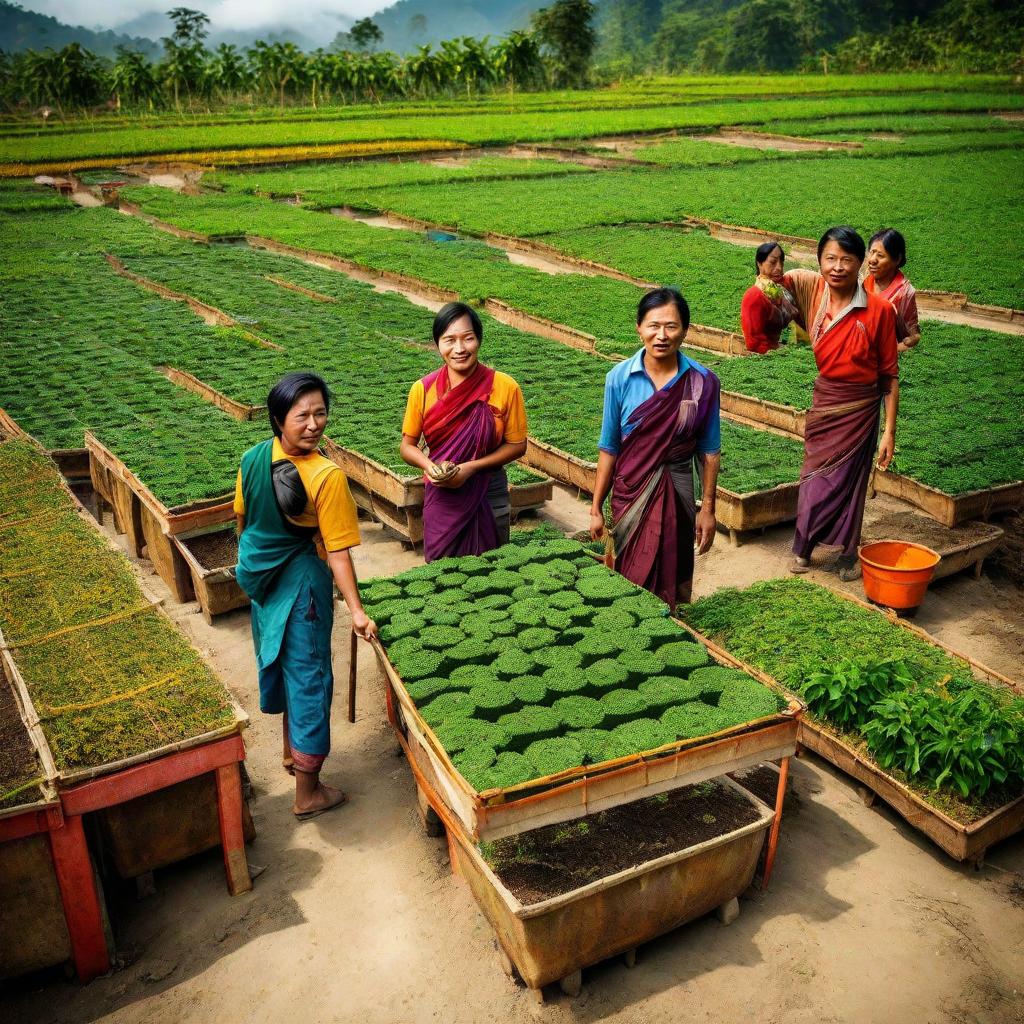Exploring Profitable Horticulture Crops for Successful Farming in Northeast India
Northeast India is abundant in natural resources and has a favorable climate for horticulture farming. With the right crops and cultivation techniques, farmers in this region can achieve sustainable income growth. However, navigating the challenges of farming in this region requires careful planning and understanding of market dynamics. In this blog post, we will explore the key factors that contribute to successful horticulture farming in Northeast India, from assessing suitable crops to marketing and risk management strategies.
Overview of horticulture farming in Northeast India
Horticulture farming plays a crucial role in the agricultural sector of Northeast India. The region is known for its diverse agro-climatic zones, which make it suitable for cultivating a wide variety of horticultural crops. Horticulture farming involves the cultivation of fruits, vegetables, flowers, and spices, among other crops. This sector not only contributes to food security but also provides significant economic opportunities for farmers in the region.
Importance of profitable crops for successful farming
Profitable crops are essential for the success of horticulture farming in Northeast India. By selecting crops with high market demand and value, farmers can maximize their returns on investment. Moreover, growing profitable crops helps in boosting the overall agricultural economy of the region. It encourages more farmers to engage in horticulture farming, leading to increased employment opportunities and income growth.
Challenges faced by farmers in the region
While horticulture farming in Northeast India holds immense potential, farmers face several challenges in realizing its benefits. Limited access to financial support and credit often hampers the adoption of advanced farming techniques. Lack of proper infrastructure, including storage facilities and transportation networks, also impedes the smooth supply and distribution of horticultural produce. Additionally, farmers in the region face challenges related to pest and disease management, climate variability, and marketing their products effectively.
Climate and Soil Conditions in Northeast India
Northeast India exhibits a diverse range of climates and soil conditions, making it suitable for growing a wide array of horticultural crops. From the tropical climate of Assam to the temperate climate of Sikkim, the region offers opportunities for cultivating both warm-season and cool-season crops. The soil ranges from fertile alluvial plains to well-drained loamy soils, providing ideal growing conditions for various crops.
Availability of Natural Resources
Northeast India is blessed with an abundance of natural resources that favor horticulture farming. The region receives ample rainfall, ensuring a sufficient water supply for irrigation. Moreover, the region is endowed with rich biodiversity, making it a hotspot for the cultivation of medicinal plants, spices, and exotic fruits. The natural resources in the region provide a strong foundation for successful horticulture farming.
Government Support and Initiatives
To promote horticulture farming in Northeast India, the government has initiated several programs and schemes. These initiatives aim to provide financial assistance, training, and technological support to farmers. The National Horticulture Mission (NHM) and the Mission for Integrated Development of Horticulture (MIDH) are some of the key programs that encourage farmers to adopt modern farming practices and improve their market linkages.
Assessing Suitable Horticulture Crops
Selecting suitable horticulture crops is a critical step in achieving profitability in farming. Farmers need to consider various factors when deciding which crops to cultivate.
Factors to consider when selecting profitable crops
- Climate-Adapted Crops: It is important to choose crops that are well-suited to the climatic conditions of Northeast India. For instance, tropical fruits like mangoes and bananas thrive in the hot and humid climate of the region, while apples and oranges are suitable for the cooler areas.
- High-Demand and Profitable Crops: Researching market demand and value for different crops is crucial. Crops like strawberries, kiwis, and mushrooms have gained popularity in recent years and offer good profit margins.
- Crop Diversification for Risk Reduction: Planting a diverse range of crops can help farmers mitigate risks associated with climate variability, pests, and diseases. By diversifying their crop portfolio, farmers can spread their risks and ensure a consistent income throughout the year.
 Cultivation Techniques and Best Practices
Cultivation Techniques and Best Practices
Understanding the cultivation techniques specific to each crop is essential for successful horticulture farming. Farmers must pay attention to soil preparation, irrigation systems, and pest management to ensure healthy plant growth.
Selecting the Right Planting Methods
Different crops have varying planting requirements. Some crops are best suited for direct seeding, while others require transplanting. Understanding the specific needs of each crop and implementing the appropriate planting methods can greatly improve crop productivity.
Implementing Efficient Irrigation Systems
Water availability is crucial for horticulture farming. Implementing efficient irrigation systems such as drip irrigation or sprinkler irrigation can help farmers optimize water usage and ensure that crops receive the right amount of water at the right time. This not only conserves water but also reduces the risk of waterlogging and related diseases.
Integrated Pest Management Approaches
Pests and diseases can significantly impact crop yield and quality. Implementing integrated pest management approaches that combine cultural, biological, and chemical control methods can help farmers effectively manage pests while minimizing the use of harmful pesticides. This promotes sustainable farming practices and protects the environment.
Marketing and Value Chain Analysis
Understanding the local and national market dynamics is crucial for successful marketing of horticulture crops. Farmers must analyze value chains and identify potential buyers to create a strong market presence.
Market Research and Analysis
Conducting market research and analysis can provide valuable insights into consumer preferences, trends, and pricing dynamics. Farmers should identify the crops that have high demand in both local and national markets and tailor their production accordingly.
Building Partnerships with Buyers and Retailers
Building long-term relationships with buyers and retailers is essential for ensuring a consistent market for horticulture crops. Farmers can establish partnerships with local grocery stores, restaurants, and online platforms to increase the visibility and reach of their products.
Creating Value-Added Products for Higher Profits
By processing and creating value-added products from horticulture crops, farmers can command higher prices and maximize their profits. Examples include producing jams, pickles, dried fruits, and herbal extracts. Value addition not only enhances the economic value of the crops but also reduces post-harvest losses.
Financial Management and Risk Mitigation
Proper financial planning and risk mitigation strategies are crucial for the success of horticulture farming. Farmers need to manage costs, monitor cash flow, and mitigate risks through crop insurance and diversification.
Budgeting and Cost Estimation
Accurate budgeting and cost estimation are essential for financial planning. Farmers should consider all the costs involved in cultivation, including inputs, labor, irrigation, transportation, and marketing expenses. This helps in identifying potential financial resources and ensures that the farm remains economically viable.
Accessing Financial Support and Credit
Farmers can seek financial support and credit from various sources such as government schemes, banks, and agricultural cooperatives. These financial resources can help farmers invest in advanced farming techniques, purchase quality inputs, and access better marketing opportunities.
Crop Insurance and Risk Management Strategies
Crop insurance provides a safety net against potential crop failures caused by natural disasters, pests, or diseases. Farmers should explore crop insurance schemes offered by the government and private insurance companies to mitigate the financial risks associated with farming. In addition, spreading the risk through crop diversification and adopting climate-resilient farming practices can reduce vulnerability to adverse conditions.
Success Stories and Case Studies
Several success stories of profitable horticulture farming in Northeast India serve as inspiration for aspiring farmers. Let’s explore a couple of case studies that highlight the achievements of farmers in the region.
Case Study: Successful Kiwi Cultivation in Assam
Mr. Rajesh Baruah, a farmer from Assam, ventured into kiwi cultivation a few years ago. Despite initial challenges, he recognized the demand for this exotic fruit in the market and decided to experiment with it. Through diligent research and guidance from agricultural experts, Mr. Baruah successfully grew and marketed kiwis. Today, he is regarded as a pioneer of kiwi cultivation in Assam and his success has inspired many other farmers to adopt this profitable crop.
Case Study: High-Value Spice Farming in Manipur
Mrs. Rina Devi, a farmer from Manipur, recognized the potential of spice farming as a high-value crop. She started growing turmeric, ginger, and black pepper on her small-scale farm. Through proper marketing and value addition, she was able to command premium prices for her products. Today, Mrs. Rina Devi’s success story serves as a testament to the profitability of spice farming in the region.
Lessons Learned and Replication Opportunities
These success stories offer valuable lessons for other farmers in Northeast India. They highlight the importance of market research, crop diversification, and accessing financial support. By replicating the strategies and techniques employed by successful farmers, others can increase their chances of achieving profitable horticulture farming.
Summary
Exploring profitable horticulture crops is essential for successful farming in Northeast India. By assessing suitable crops, understanding cultivation techniques, analyzing market dynamics, adopting financial management strategies, and learning from success stories, farmers can maximize their income and contribute to the overall development of the region. It is crucial for farmers to embrace horticulture farming as a sustainable means of livelihood and utilize the abundant natural resources and government support available to them.
 FAQs (Frequently Asked Questions)
FAQs (Frequently Asked Questions)
What are the main challenges faced by farmers in Northeast India?
Farmers in Northeast India face challenges such as limited access to financial support and credit, inadequate infrastructure, pest and disease management, climate variability, and effective marketing of their products.
Which horticulture crops are suitable for the region’s climate?
Northeast India’s diverse agro-climatic zones offer opportunities for cultivating a wide variety of horticultural crops. Some of the suitable crops for the region include tropical fruits like mangoes and bananas, spices like turmeric and ginger, and temperate fruits like apples and oranges.
How can farmers access financial support and credit for horticulture farming?
Farmers can access financial support and credit for horticulture farming through government schemes, banks, and agricultural cooperatives. There are various programs and initiatives that provide financial assistance and training to farmers in Northeast India.
What are some success stories of profitable horticulture farming in Northeast India?
There are several success stories of profitable horticulture farming in Northeast India. One such example is the successful cultivation of kiwi in Assam by Mr. Rajesh Baruah. Another example is the high-value spice farming by Mrs. Rina Devi in Manipur.
How can farmers mitigate risks in horticulture farming?
Farmers can mitigate risks in horticulture farming by adopting crop insurance schemes, diversifying their crop portfolio, and implementing climate-resilient farming practices. Proper financial planning and risk management strategies are crucial for mitigating risks in horticulture farming and ensuring its long-term sustainability.


 Cultivation Techniques and Best Practices
Cultivation Techniques and Best Practices FAQs (Frequently Asked Questions)
FAQs (Frequently Asked Questions)